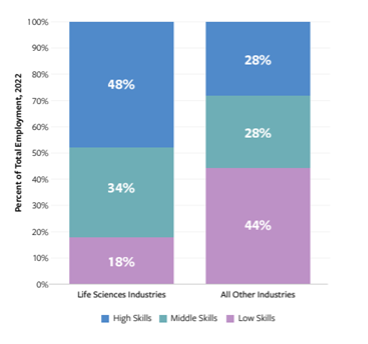Community Colleges Help Address Skills Gap
October 3, 2023
Source: drugdu
 447
447
By Jennifer Markarian

Pictured: Illustration of students sitting at a table/iStock, undrey
Although the biopharma industry tends to focus on high-skill workers with advanced science and engineering degrees, just over half of entry-level jobs in the U.S. life sciences require skills considered middle and lower level that could be filled by people with less than a four-year degree, according to a recent report on life sciences workforce trends by the Coalition of State Biosciences Institutes (CSBI), which promotes bioscience education and workforce development, and research group TEConomy Partners.
“The share of middle-skills workers needed for entry-level positions in life sciences has held steady over the past decade,” Liisa Bozinovic, chair of CSBI, told BioSpace. Individuals with degrees from the U.S. network of two-year Advanced Technical Education biotechnology programs, which provide hands-on, industry-relevant training, have been successfully filling these positions, she added.
Organizations Collaborate to Promote Biotech Education
InnovATEBIO, a National Science Foundation Advanced Technology Education (NSF ATE) Center, supports biotechnology education in community colleges as well as dual-credit programs with high schools that can lead to certificates and further training. At a national summit in June coordinated by CSBI and InnovATEBIO, the organizations sought to facilitate more state-level collaborations.

Skills composition of entry-level positions/CSBI
“We know that some states are doing an admirable job of bringing their community college and other academic partners together with industry, trade associations and governmental agencies to develop targeted programs that both meet and stay abreast of the industry’s rapidly evolving talent needs,” Linnea Fletcher, executive director of the InnovATEBIO National Biotech Education Center, said in a press release. “We hope the Summit and its aftermath will provide more states with tools to develop similar strategic collaborations that will address gaps in their own states.”
These efforts are not without their hurdles, however. A recent whitepaper by the National Institute for Innovation in Manufacturing Biopharmaceuticals (NIIMBL) and InnovATEBIO pointed out that while more than 100 community college programs exist, some are facing declining enrollment.
“Challenges faced by two-year biotechnology and biomanufacturing degree programs include low public awareness of biopharmaceutical manufacturing technician careers as well as longstanding biases against community college education,” the authors wrote.
Speaking with BioSpace, NIIMBL Workforce Director John Balchunas, a coauthor of the whitepaper, reiterated these concerns. “The biopharmaceutical industry has long held the bachelor’s degree as the ticket for entry into the industry,” he said. But he added that there is a shift to non-traditional pathways: “We see evidence that this is changing, as many of the larger companies prioritize ‘skills first’ approaches to hiring and no longer require bachelor’s degrees for key technician roles.”
Indeed, the CSBI report found that companies are showing more flexibility in the types of credentials they will consider for new hires. “We attribute [revisions in job requirements] to drivers such as outsized demand and competition for talent, but also to a realization that candidates with bachelor’s degrees are not always the right fit for those roles,” Bozinovic said.
It will take time to change the risk tolerances of a broader range of technical hiring managers, Balchunas said. In addition, more people in the industry need to become familiar with non-degree and community college pathways. NIIMBL hopes to expose industry to these solutions for broadening the talent funnel to drive a paradigm shift in biopharma hiring.
“As NIIMBL continues to engage our industry members, much of the focus is on ensuring that, within each company, all of the various stakeholders—technical hiring managers and the departments of human resources and talent acquisition—collectively ‘own’ the talent problem,” Balchunas said. “We’re beginning to see more cross-functional communication and stakeholders working together to find solutions.”
Read more on
- Phase III Clinical Trial of Recombinant Staphylococcus Aureus Vaccine Progressing Normality January 21, 2026
- Its drug marketing application for injectable iza-bren has been accepted January 21, 2026
- Kain Technology withdrew a drug registration application, resulting in a profit reduction of 111 million yuan in 2025 January 21, 2026
- Received Notice of Approval for Drug Clinical Trial January 21, 2026
- Breaking news! AstraZeneca to be delisted from Nasdaq. January 21, 2026
your submission has already been received.
OK
Subscribe
Please enter a valid Email address!
Submit
The most relevant industry news & insight will be sent to you every two weeks.



